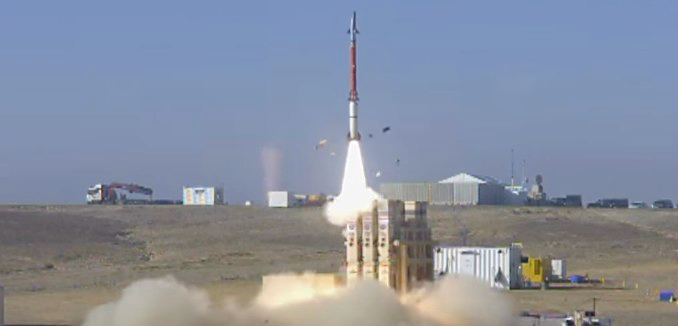Israel is conducting final tests before deploying what military experts call one of the most advanced missile defense systems in the world, one that in many ways surpasses the capabilities of the United States.
The multi-platform system includes the Iron Dome, which stops low-accuracy rockets like those fired by Hamas from the Gaza Strip; Arrow-3, which could be used to stop Iranian long-range nuclear ballistic missiles by, in the words of The Washington Post, “knock[ing] out enemy targets in space by deploying ‘kamikaze satellites,’ or ‘kill vehicles,’ that track their targets”; and David’s Sling, which intercepts medium-range missiles like those controlled by Hezbollah in Lebanon. The Israeli Defense Ministry, which has called David’s Sling “the world’s most revolutionary innovation in the family of interceptor systems,” announced on Tuesday that major components of the system will be delivered to the Israeli Air Force “over the course of several weeks” and will be implemented alongside Arrow-3 and Iron Dome later this year.
Additionally, Israel’s new X-Band radar system will allow it to detect incoming missiles from up to 600 miles out, compared to its current radar tracking capability of 100 miles. The system can also calculate the trajectories of rockets and missiles, stopping the incoming projectiles if they are intended for cities, military bases, or important infrastructure, while holding its fire if the incoming projectiles end up landing in unpopulated areas.
“I define the system as pioneering,” Uzi Rubin, the former director of Israel’s missile defense program, told the Post. “Even the United States doesn’t have anything as complex, as sophisticated.”
Israel’s emphasis on multiple kinds of missile defense reflects the threats it faces on simultaneous fronts. In the summer of 2014, according to the IDF, Hamas fired more than 4,000 rockets at Israel, 90 percent of which were intercepted by Iron Dome. The IDF also believes that Hezbollah could have up to 100,000 rockets positioned in Lebanon. Hezbollah leader Hassan Nasrallah threatened to strike Israeli ammonia plants two weeks ago, saying that it would lead to tens of thousands of deaths and the equivalent devastation of a nuclear bomb.
The system was developed as part of Israel’s $3 billion per year military aid grant from the United States, 75 percent of which must be spent on American equipment and technology. American firms that helped build and develop the systems include Raytheon, Boeing, and Lockheed Martin.
A video accompanying the Post story is embedded below.




